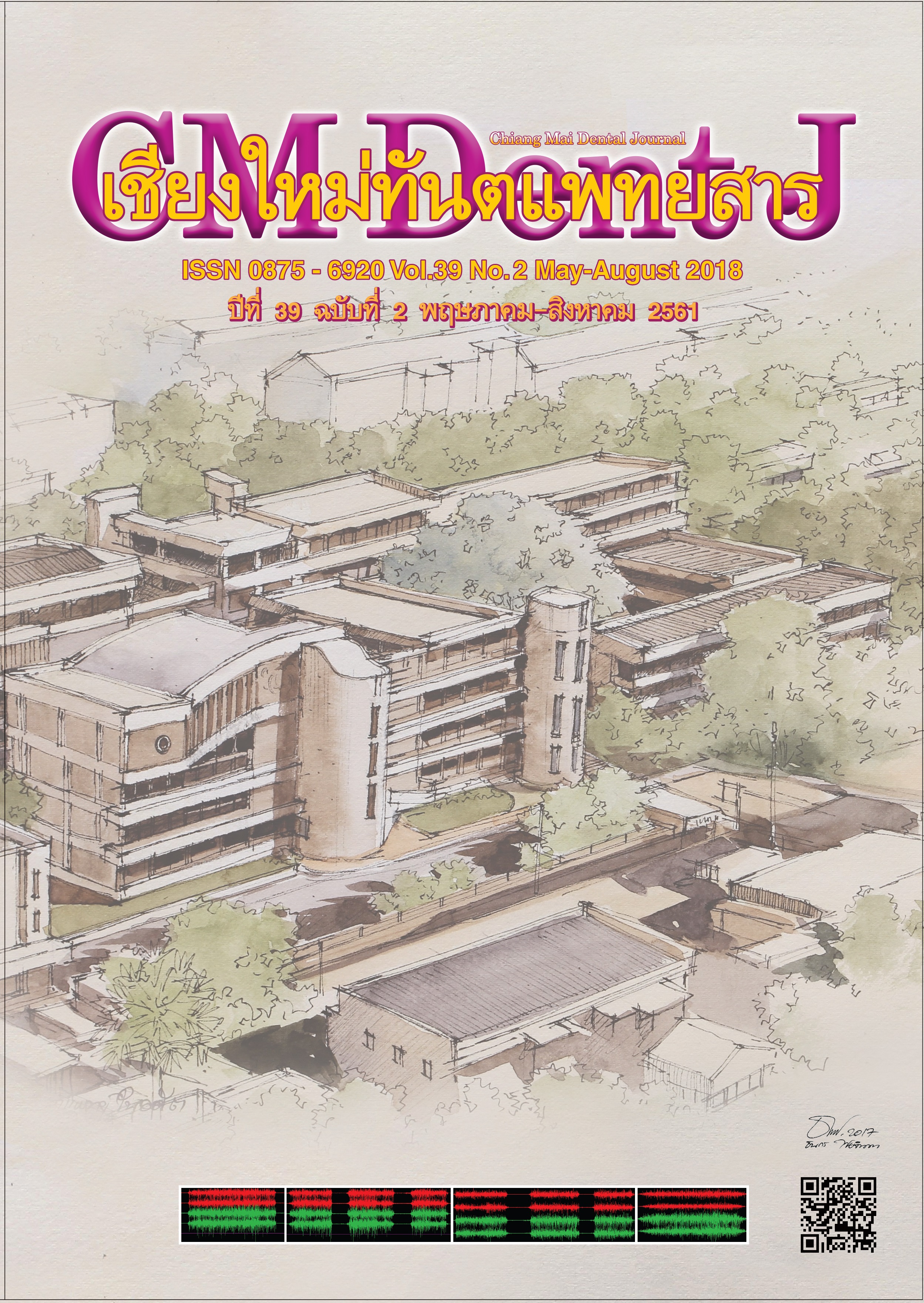Effectiveness of Individual Media on Tooth-brushing Skill Among Parents of Children Aged 3-5 Year-old in Khuamung Subdistrict, Saraphi District, Chiang Mai Province
Main Article Content
Abstract
Objective: To develop individual media on tooth-brushing skill for parents of 3-5-year-old children and to evaluate the effectiveness of the media.
Materials and Methods: The study was divided into two steps, in which the first step was the development of a template for individual media on tooth-brushing skill for parents and the second step was the evaluation of the parents’ tooth-brushing skill and the children’s oral hygiene. A Comparison was performed between experimental and control groups; the former received the individual media and the latter did not. The comparison was performed both at baseline and at three-month follow-up. Interviews to determine parental satisfaction after receipt of the individual media were also conducted. Data from all subjects were collected between February and June 2016. Twenty-four pairs of parents and children were randomly divided into two groups of 12 pairs. Parents in the control group received an oral hygiene instruction review and practiced brushing their child’s teeth, under the supervision of a dentist. Parents in the experimental group received the developed individual media in addition to the routine oral hygiene instruction review and supervised practice. Data were analyzed using descriptive statistics, the McNemar test, the Pearson Chi-square test and the t-test.
Results: The study revealed that the use of individual media on tooth-brushing skill improved the parents’ tooth-brushing skill and also the children’s oral hygiene. An individually-designed poster was developed, using a mass customized concept. Parents’ tooth-brushing skills in the experimental group were significantly improved compared with those in the control group (p < 0.001) on all surfaces of the teeth except the occlusal surface, because the parents had the correct skills to brush before practicing. The difference in the mean plaque index score in the experimental group was significantly higher than in the control group (p = 0.007). The level of satisfaction with the individual media in the experimental group was good.
Conclusions: The use of individual media to remind parents at home of the previously practiced tooth-brushing skill can improve their skills and their children’s oral hygiene.
Article Details
References
Dental Health Division. The 7th National oral health survey of Thailand report 2012. Nonthaburi: Department of Health, Ministry of Public Health; 2013 (in Thai).
Ayhan H, Suskan E, Yildirim S. The effect of nursing or rampant caries on height, body weight and head circumference. J Clin Pediatr Dent 1996; 20(3): 209-212.
Tinanoff N, O'Sullivan DM. Early childhood caries: overview and recent findings. Pediatr Dent 1997; 19(1): 12-16.
American Academy of Pediatric Dentistry. Policy on Early Childhood Caries (ECC): Classifications, Consequences, and Preventive Strategies. Pediatr Dent 2016; 36(6): 14-15.
Sarvia ME, Bush JP, Mourino AP. Psychomotor skills and incentive as predictors in a children’s toothbrushing program. J Pedod 1989; 14: 31-35.
Dental Health Division. Guidelines for the provision of integrated and proactive oral health promotion services based on empirical data in children 0-5 years. Nonthaburi: Department of Health, Ministry of Public Health; 2011 (in Thai).
Davies GM, Duxbury JT, Boothman NJ, Davies RM, Blinkhorn AS. A staged intervention dental health promotion programme to reduce early childhood caries. Community Dental Health 2005; 22(2): 118-122.
Chatiketu P, Kantam W, Theerapiboon U. Effectiveness of Village Health Volunteer using Dental Care Kit for Home Visit in 0-2 Years Old Children. Chiang Mai Dental Journal 2014; 35(1), 119-130.
Pine BJ. Mass Customization: The New Frontier in Business Competition. Boston: Harvard Business School Press. 1993.
Vikakun O, Punwutikorn J, Jungsiriwattanathumrong W. Dental management in the medically compromised patient. Bangkok. Tech and Journal Publication. 1994.
Niederman R, Sullivan TM. Oral Hygiene Skill Achievement Index I. J Periodontol 1981; 52(3): 143-149.
Ramfjord SP. The Periodontal Disease Index (PDI). J Periodontol 1967; 38(6): 602-610.
World Health Organization. Oral health survey basic methods-5th edition. Geneva 2013.
Best JW, Kahn JV. Research in education (8th ed.). Boston 1998.
Silveira GD, Borenstein D, Fogliatto FS. Mass customization: Literature review and research directions. Int J Prod Econ 2001; 72 (1): 1-13.
Martignon S, González MC, Santamaría RM, Jácome-Liévano S, Muñoz Y, Moreno P. JOral-health workshop targeted at 0-5-yr. old deprived children's parents and caregivers: effect on knowledge and practices. Clin Pediatr Dent 2006; 31(2): 104-108.
Thanakanjanaphakdee W, Triratvorakul C. Effectiveness of parental hands-on toothbrushing instruction toward the 1-year incremental dmf rate of 9-18 month-old children. J Dent Assoc Thai 2010; 60: 85-93 (in Thai).
Arnim SS. The use of disclosing agents for measuring tooth cleanliness. J Periodontol 1963; 34(3): 227-245.
Bullen C, Rubenstein L, Saravia ME, Mourino AP. Improving children's oral hygiene through parental involvement. ASDC J Dent Child 1988; 55(2): 125-128.
Arunakul M, Kuphasuk Y, Boonyathanasit R. Effectiveness of oral hygiene instruction media on periodontal health among hearing impaired children. Southeast Asian J Trop Med Public Health 2012; 43(5): 1297-1303
Garg S, Kapoor KK. The quantitative gingival bleeding index. J Indian Dent Assoc 1985; 57(3): 112-113.
Axelsson P, Lindhe J. Effect of fluoride on gingivitis and dental caries in a preventive program based on plaque control. Community Dent Oral Epidemiol 1975; 3(4), 156-160.


